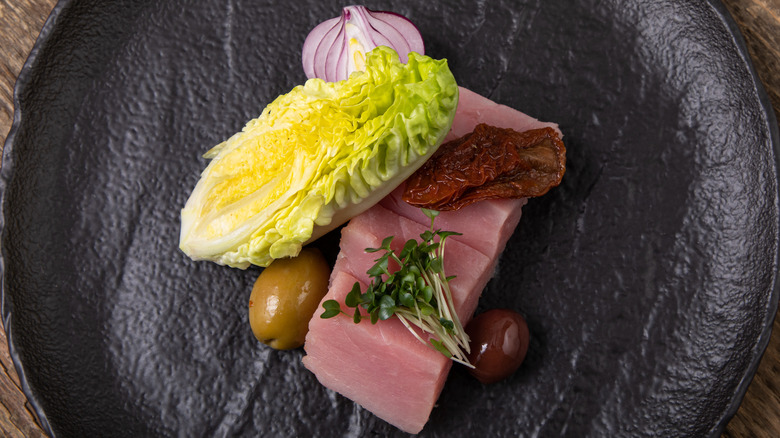The Important Oil Rule You Need To Know For Tuna Confit
Maybe you've heard of duck confit, the dish served in every French restaurant. It's usually a silky, tender leg of duck served with escarole salad or pomme puree. But what really is confit? Well, the word is a derivation of the French verb "confire," which means to preserve (via CNRTL). Confit, however, refers to a particular method of preserving food that came into practice before the invention of the refrigerator. Any food that is slowly cooked and preserved in fat is confit.
So what is tuna confit? Tuna confit is what you get when you drench tuna in olive oil and cook it gently with aromatics, per Masterclass. This results in a fatty, tender fillet enriched with subtle notes of garlic and herbs. Sure, a gourmet, oil-packed canned tuna often comes with good quality olive oil, but the difference is in the way the tuna is cooked. Canned tuna is quickly steamed at high temperatures, while tuna confit is slowly poached at low heat. The resulting textures are remarkably distinct: Canned tuna is dry, while tuna confit is far moister and smooth like paté. But if you want to try making your own tuna confit, you have to remember this crucial detail.
Cover your tuna in oil
The key to any confit is to completely cover the ingredient in oil. The science behind this is simple — when the tuna is submerged in oil, the oil creates a layer of fat on the surface that works as a barrier against water and bacteria (via Science of Cooking). This serves two purposes: The hydrophobic oil keeps water in during the cooking process, but also keeps bacteria out. In the same way that jams are preserved with an excess amount of sugar, confit is preserved with an excess of oil or fat.
If you fail to cover your tuna in oil, you are technically shallow-frying it instead of preserving it through the confit method. So before you put your tuna in the pot, make sure you have enough oil for the job. Although this may seem like deep frying, the lower cooking temperature of a confit prevents the tuna steak from drying out. Without the low-and-slow cooking method, you'd be left with something that resembles flaky canned tuna with an unappetizing crust. Using high-quality olive oil is a good idea, and Lifehacker recommends using peppery olive oil when preparing tuna confit for greater depth of flavor; just remember to cover every inch of your tuna with it. And for the future, make sure to watch out for these mistakes when you make confit.

